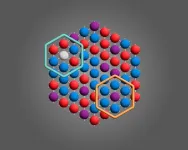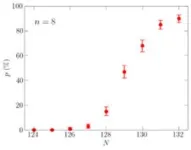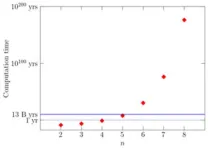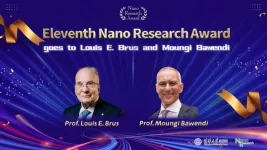(Press-News.org) By Tom Garlinghouse for the Princeton University Department of Physics
Not all magnets are the same. When we think of magnetism, we often think of magnets that stick to a refrigerator’s door. For these types of magnets, the electronic interactions that give rise to magnetism have been understood for around a century, since the early days of quantum mechanics. But there are many different forms of magnetism in nature, and scientists are still discovering the mechanisms that drive them.
Now, physicists from Princeton University have made a major advance in understanding a form of magnetism known as kinetic magnetism, using ultracold atoms bound in an artificial laser-built lattice. Their experiments, chronicled in a paper published this week in the journal Nature, allowed the researchers to directly image the microscopic object responsible for this magnetism, an unusual type of polaron, or quasiparticle that emerges in an interacting quantum system.
“This is very exciting,” said Waseem Bakr, professor of physics at Princeton and the senior author of the paper. “The origins of the magnetism have to do with the motion of impurities in the atomic array, hence the name kinetic magnetism. This motion is highly unusual and leads to magnetism that is robust even at very high temperatures. Combined with the tunability of the magnetism with doping—the addition or removal of particles—kinetic magnetism is very promising for device applications in real materials.”
Bakr and his team studied this novel form of magnetism on a level of detail unrealized in previous research. With the control afforded by ultracold atomic systems, the researchers have been able to visualize, for the first time, the finely-grained physics that gives rise to kinetic magnetism.
“We have the capability in our lab to look at this system at the single atom and single site level in the lattice and take ‘snapshots’ of the subtle quantum correlations between the particles in the system,” Bakr said.
For several years, Bakr and his research team have studied quantum states by experimenting with ultracold subatomic particles known as fermions in a vacuum chamber. They have devised a sophisticated apparatus that cools atoms to ultracold temperatures and loads them into artificial crystals known as optical lattices created using laser beams. This system has allowed the researchers to explore many interesting aspects of the quantum world involving the emergent behavior of ensembles of interacting particles.
One early theoretically proposed mechanism for magnetism that laid the groundwork for the team’s current experiments is known as Nagaoka ferromagnetism, named for its discoverer Yosuke Nagaoka. Ferromagnets are ones in which the electrons’ spin states all point in the same direction.
While a ferromagnet with aligned spins is the most familiar type of magnet, in the simplest theoretical setting, strongly interacting electrons on a lattice actually tend towards antiferromagnetism, in which the spins align in alternating directions. This preference for anti-alignment of neighboring spins occurs as the result of an indirect coupling of neighboring electron spins known as superexchange. However, Nagaoka theorized that ferromagnetism may also result from a totally different mechanism, one determined by the motion of intentionally added impurities, or dopants. This can best be understood by imagining a two-dimensional square lattice in which each lattice site, with one exception, is occupied by an electron. The unoccupied site (or hole dopant) wanders around in the lattice. Nagaoka found that if the hole moves in an environment of aligned spins or a ferromagnet, the different trajectories for the motion of the hole quantum mechanically interfere with each other. This enhances the spreading out of the hole’s quantum position and reduces the kinetic energy, a favorable outcome.
Nagaoka’s theorem quickly gained recognition because there are few rigorous proofs purporting to explain ground states of systems of strongly interacting electrons. But observing the consequences through experiments posed a difficult challenge owing to the strict requirements of the model. In the theorem, the interactions needed to be infinitely strong and only a single dopant was allowed. Over five decades after Nagaoka proposed his theory, other researchers realized that these unrealistic conditions could be relaxed significantly in lattices with a triangular geometry.
To conduct the experiment, the researchers used vapors of lithium-6 atoms. This isotope of lithium contains three electrons, three protons and three neutrons. “The odd total number makes this a fermionic isotope, which means that the atoms behave similarly to electrons in a solid-state system,” said Benjamin Spar, a graduate student in physics at Princeton University and a co-lead author of the paper. When these gases are cooled down using laser beams to extreme temperatures only a few billionths of a degree above absolute zero, their behavior begins to be governed by the principles of quantum mechanics rather than the more familiar classical mechanics.
“Once we’ve achieved this quantum system, the next thing we do is load the atoms into the triangular optical lattice. In the cold atom setup, we can control how fast atoms move around or how strongly they interact with each other,” said Spar.
In many strongly interacting systems, the particles in a lattice are organized into a “Mott insulator,” which is a state of matter in which a single particle occupies each site of the lattice. In this state, there are weak antiferromagnetic interactions due to superexchange between the spin of electrons on neighboring sites. But instead of using a Mott insulator, the researchers used a technique called “doping,” which either removes some particles, thereby leaving “holes” in the lattice, or adds extra particles.
“We don’t start with one atom per site in our experiment,” said Bakr. “Instead, we dope the lattice with holes or particles. And when you do this, you find that there is a much more robust form of magnetism that is observed in these systems with higher energy scale than the usual superexchange magnetism. This energy scale has to do with hopping of the atoms in the lattice.”
Leveraging the much larger lattice site spacings in optical lattices compared to real materials, the researchers were able to see what was occurring on the single-site level with an optical microscope. They found that the objects responsible for this new form of magnetism are a new type of magnetic polaron.
“A polaron is a quasiparticle that emerges in a quantum system with many interacting constituents,” said Bakr. “It acts very much like a regular particle, in the sense it has properties like a charge, a spin, and effective mass, but it is not an actual particle like an atom. In this case, it is a dopant that moves around with a disturbance to its magnetic environment, or how the spins around it are aligned relative to each other.”
In real materials, this new form of magnetism has previously been observed in so-called moiré materials consisting of stacked two-dimensional crystals, and this has only occurred in the last year.
“The probes of magnetism available for these materials are limited. Experiments with moiré materials have measured macroscopic effects, associated with how a large piece of material responds when a magnetic field is applied,” said Spar. “With the cold atom setup, we can dig deep into the microscopic physics responsible for the magnetism. We have taken detailed images revealing the spin correlations around the mobile dopants. For example, we find that a hole dopant surrounds itself with anti-aligned spins as it moves around, while a particle dopant does the opposite, surrounding itself with aligned spins.”
This research has far-reaching implications in condensed matter physics, even beyond understanding the physics of magnetism. For example, more complex versions of these polarons have been hypothesized to lead to mechanisms for hole dopants to pair up, which may result in superconductivity at high temperatures.
“The most exciting part of this research is that it truly is concurrent with studies in the condensed matter community,” said Max Prichard, a graduate student and co-lead author of the paper. “We are in the unique position to provide insight to a timely problem from a totally different angle, and all parties benefit.”
Looking forward, the researchers are already devising new and innovative ways to further probe this new, exotic form of magnetism—and investigate the spin polaron in greater detail.
“In this first experiment, we’ve simply taken snapshots of the polaron, which is only the first step,” said Prichard. “But we’re now interested in doing a spectroscopic measurement of the polarons. We want to see how long the polarons live in the interacting system, to measure the energy binding together a polaron’s constituents and its effective mass as it propagates in the lattice. There is a lot more to do.”
Other members of the team are Zoe Yan, now at the University of Chicago, and theorists Ivan Morera, University of Barcelona, Spain, and Eugene Demler, Institute of Theoretical Physics in Zurich, Switzerland. The experimental work was supported by the National Science Foundation, the Army Research Office and the David and Lucile Packard Foundation.
The study, “Directly imaging spin polarons in a kinetically frustrated Hubbard system,” by Max Prichard, Benjamin Spar, Ivan Morera, Eugene Demler, Zoe Yan, and Waseem S. Bakr was published online in the journal Nature on May 8, 2024 (DOI:10.1038/s41586-024-07356-6).
END
Princeton physicists reveal the microscopic basis of a new form of quantum magnetism
Team directly imaged the microscopic object responsible for this magnetism, an unusual type of polaron
2024-05-09
ELSE PRESS RELEASES FROM THIS DATE:
Oikopleura who? Species identity crisis in the genome community
2024-05-09
When two animals look the same, eat the same, behave the same way, and live in similar environments, one might expect that they belong to the same species.
However, a tiny zooplankton skimming the ocean surfaces of microscopic food particles challenges this assumption. Researchers from Osaka University, University of Barcelona and the Okinawa Institute of Science and Technology (OIST) have analyzed the genome of Oikopleura dioica from the Seto Inland Sea, the Mediterranean, and the Pacific Ocean around the Okinawa Islands, and in doing so, they have raised numerous questions about speciation and the role of gene location in ...
Developed compiler acceleration technology for quantum computers
2024-05-09
[Highlights]
- Developed a new compilation method to generate optimal sequences to be executed on quantum computers
- The new method is based on a probabilistic approach and reduces the time to search for the optimal sequence by several orders of magnitude.
- Expected to contribute to quantum information processing at quantum nodes that support the quantum internet
[Abstract]
The National Institute of Information and Communications Technology (NICT, President: TOKUDA Hideyuki, Ph.D.), RIKEN (President: GONOKAMI Makoto, Ph.D.), Tokyo University of Science (President: Dr. ISHIKAWA Masatoshi), and the University of Tokyo (President: FUJII Teruo, Ph.D.) succeeded ...
Report: Governments falling short on promises of effective biodiversity protection
2024-05-09
WASHINGTON— A new analysis of the world’s largest 100 marine protected areas (MPAs) published today in Conservation Letters suggests that governments are falling short on delivering the promise of effective biodiversity protection due to slow implementation of management strategies and failure to restrict the most impactful activities.
The assessment, titled “Ocean protection quality is lagging behind quantity: Applying a scientific framework to assess real marine protected area progress ...
Study shows how night shift work can raise risk of diabetes, obesity
2024-05-09
Just a few days on a night shift schedule throws off protein rhythms related to blood glucose regulation, energy metabolism and inflammation, processes that can influence the development of chronic metabolic conditions.
The finding, from a study led by scientists at Washington State University and the Pacific Northwest National Laboratory, provides new clues as to why night shift workers are more prone to diabetes, obesity and other metabolic disorders.
“There are processes tied to the master biological clock in our brain that are saying that day ...
Eleventh Nano Research Award goes to Louis E. Brus and Moungi Bawendi
2024-05-09
Recently, Nano Research announced awardees of the 11th Nano Research Award. Two outstanding scientists, Professor Louis E. Brus of Columbia University and Professor Moungi Bawendi of Massachusetts Institute of Technology, have been awarded this honor.
The Nano Research Award, established by the journal Nano Research together with Tsinghua University Press (TUP) and Springer Nature in 2013, aims to recognize outstanding contributions to nano research by an individual scientist. The winner is selected by the Award Committee ...
Traffic injuries to low-income NYC residents fell 30% in first five years of ‘vision zero’ road safety program, NYU study finds
2024-05-09
Among New Yorkers with low incomes, the “Vision Zero” initiative to stem roadway crashes resulted in a marked, 30% reduction in traffic injuries of varying severity from early 2014 – when the city government launched the program – until 2019, according to a new study conducted at New York University.
The study, scheduled for publication May 8 at 4:00 p.m. (ET) in the American Journal of Public Health, revealed this trend of improved safety by comparing Medicaid-covered injury ...
AI tool instantly assesses self-harm risk
2024-05-09
Suicidality hit new record high in U.S. in 2022
New tool was 92% effective at predicting four variables related to self-harm
AI uses a small set of judgment and contextual variables as opposed to big data, and strongly supports the hypothesis of a standard model of mind
EVANSTON, Ill. --- A new assessment tool that leverages powerful artificial intelligence was able to predict whether participants exhibited suicidal thoughts and behaviors using a quick and simple combination of variables.
Developed by researchers at Northwestern University, the University of Cincinnati (UC), Aristotle ...
An epigenome editing toolkit to dissect the mechanisms of gene regulation
2024-05-09
Understanding how genes are regulated at the molecular level is a central challenge in modern biology. This complex mechanism is mainly driven by the interaction between proteins called transcription factors, DNA regulatory regions, and epigenetic modifications – chemical alterations that change chromatin structure. The set of epigenetic modifications of a cell’s genome is referred to as the epigenome.
In a study just published in Nature Genetics, scientists from the Hackett Group at EMBL Rome have developed a modular epigenome editing platform – a system to program epigenetic modifications at any location in the genome. The system allows scientists to study the impact ...
How aging clocks tick
2024-05-09
Aging clocks can measure the biological age of humans with high precision. Biological age can be influenced by environmental factors such as smoking or diet, thus deviating from the chronological age that is calculated using the date of birth. The precision of these aging clocks suggests that the aging process follows a programme. Scientists David Meyer and Professor Dr Björn Schumacher at CECAD, the Cluster of Excellence Cellular Stress Responses in Aging-Associated Diseases of the University of Cologne, have now discovered that aging clocks actually measure the increase in stochastic changes in cells. The study ‘Aging clocks based on accumulating stochastic variation’ ...
miR-146a rs2910164 C>G Polymorphism and Wilms tumor susceptibility in Eastern Chinese children
2024-05-09
Background and objectives
Wilms tumor is the most common renal malignancy in children. miR-146a, a highly conserved small noncoding RNA, plays a critical role in various human diseases. Increasing studies have suggested that rs2910164 C>G polymorphism in miR-146a is associated with susceptibility to cancers. However, miR-146a rs2910164 C>G polymorphism influence on Wilms tumor remains unknown. The aim of this study was to evaluate the relationship between miR-146a rs2910164 C>G polymorphism and Wilms ...
LAST 30 PRESS RELEASES:
Biomedical and life science articles by female researchers spend longer under review
Forgetting in infants can be prevented in mice by blocking their brain’s immune cells
Blocking immune cells in the brain can prevent infant forgetting
AI-driven ultrafast spectrometer-on-a-chip: A revolution in real-time sensing
World enters “era of global water bankruptcy”; UN scientists formally define new post-crisis reality for billions
Innovations in spatial imaging could unlock higher wheat yields
A twitch in time? Quantum collapse models hint at tiny time fluctuations
Community water fluoridation not linked to lower birth weight, large US study finds
Stanford University’s Guosong Hong announced as inaugural recipient of the SPIE Biophotonics Discovery’s Impact of the Year Award
Ice, ice, maybe: There’s always a thin layer of water on ice — or is there?
Machine learning lends a helping ‘hand’ to prosthetics
Noninvasive brain scanning could send signals to paralyzed limbs
Community water fluoridation and birth outcomes
SGLT2 inhibitors vs GLP-1 receptor agonists for kidney outcomes in individuals with type 2 diabetes
Long-term exposure to air pollution and risk and prognosis of motor neuron disease
Five-year absolute risk–based and age-based breast cancer screening in the US
Study finds elevated alcohol involvement in suicides of lesbian, gay and bisexual women
Air pollution may increase the risk of the neurodegenerative disease ALS
Chronic kidney disease poisons patients’ hearts, scientists discover
Hollings researchers reveal why some pancreatic tumors behave differently
DNA ties gut motility to vitamin B1
Study suggests pathway for life-sustaining conditions in Europa’s ocean
Researchers discover potential new target to treat Parkinson’s disease
Global societies unite to address environmental threats to heart health
Artificial light at night extends pollen season
Women see AI as riskier than men do
Push and pull in models of human migration
Mapping comedic timing, ta-da!
SEOULTECH researchers reveal strong public support for hydrogen fuel cell trucks
Dongguk University develops a new way to produce cheaper, more efficient green hydrogen
[Press-News.org] Princeton physicists reveal the microscopic basis of a new form of quantum magnetismTeam directly imaged the microscopic object responsible for this magnetism, an unusual type of polaron





